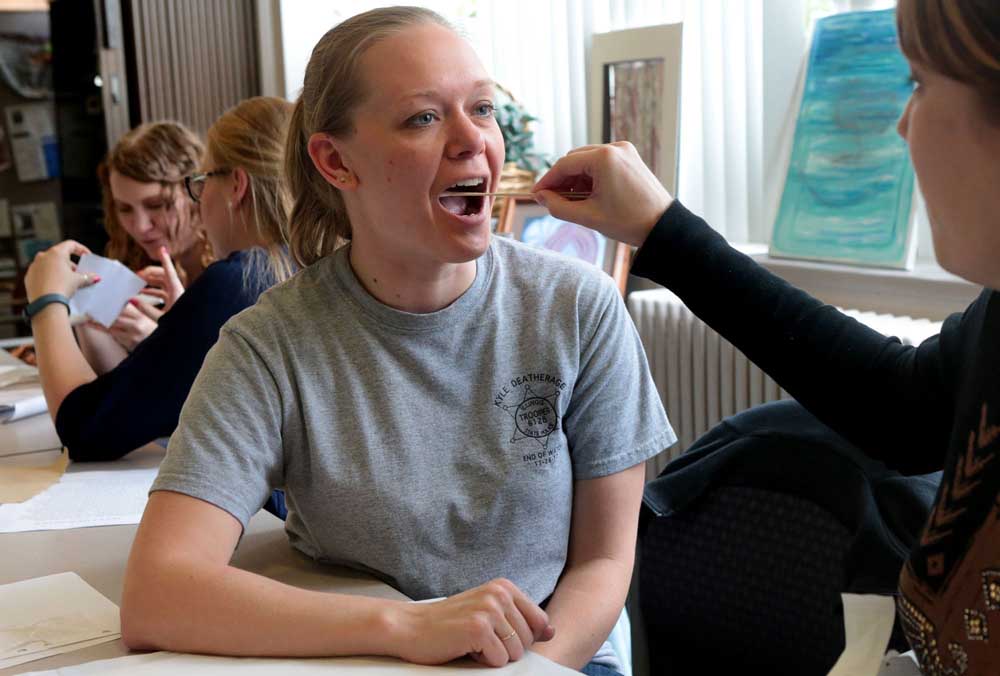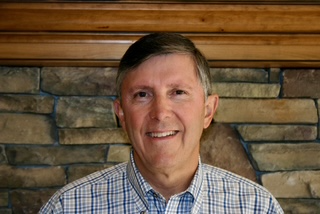Nurses turn into crime fighters
Published 12:00 am Sunday, June 7, 2015

- Laurie Skrivan / St. Louis Post-DispatchER nurse Kira Stearns, right, swabs the mouth of her partner, ER nurse Christina Isringhausen, to collect DNA at a Sexual Assault Nurse Examiner certification workshop in Clayton, Missouri.
ST. LOUIS — Ka’Saundra Reynolds was walking her dog just before the sun rose when a shadowy figure lurking behind some bushes caught her eye.
It was a man who, seconds later, knocked her to the ground and ripped her pants.
“I just couldn’t roll over and play dead,” said Reynolds, then 59. “I knew that if he succeeded in raping me, I would never come back from that.”
So she dug her nails into him as hard as she could, wherever she could.
“All I could think was to grab, twist and pull.”
Her faithful Shih Tzu, named Baby Cakes, gnawed at the attacker’s ankles as Reynolds screamed, clawed and struggled her way free. As she ran, he tried to bring her down on the steps to her door. When her daughter opened it, the man vanished.
While waiting for help, the daughter wrapped her mother’s bloodied fingertips in bandages. An ambulance delivered Reynolds to St. Mary’s Health Center in Richmond Heights and the waiting care of Joyce Sanchez.
Sanchez was more than an emergency room nurse. She was one of a growing number of Sexual Assault Nurse Examiners, specially trained to see a victim like Reynolds as a portable crime scene as well as a patient. What Sanchez did that March day in 2007 would provide the key to putting Reynolds’ attacker in prison about a year later.
Forensic nurses
In 1992, 72 registered nurses formed the International Association of Forensic Nurses, a group that has since grown to 3,000.
Some states, such as Texas, have laws requiring that sexual assault victims be treated by SANE certified nurses, even if it means a transfer to a hospital that has one.
But in areas like St. Louis, proponents say, fractured jurisdictions make evidence handling a bit more hit-and-miss. Hospitals may have a trained nurse available or not. Kathy Howard, the forensic nursing coordinator for St. Louis University Hospital, said the inconsistency is a shame.
“Nurses and physicians don’t learn forensics in school, and it’s not part of their orientation to the ER,” Howard said. “DNA is becoming so sophisticated, and we’re finding it more and more now. You want a nurse who knows where to look, how to get it and how to do it properly.”
Helen Sandkuhl remembers that when she started her nursing career about four decades ago, sexual assault victims received a pelvic exam and an offer of emergency contraception. Now, as director of emergency room nursing for St. Louis University Hospital, she makes sure a forensically trained nurse is always available.
A victim arriving there goes to a private area, with the option of having police and a victim’s advocate respond. The idea is to offer a joint interview, so the victim has to describe the attack only once.
If the victim chooses to go it alone, nurses provide information about counseling offered by the YWCA and store rape kit evidence in case of a later decision to pursue charges.
An exam with a forensic nurse can take four to five hours, including medical treatment, an interview, photographing of injuries and collection and documentation of evidence.
Sandkuhl said she wants to expand the evidence collection to include all victims of violent crimes, whose bodies may have carried in telltale clues about their attackers. Occasionally, her nurses have been called upon to examine suspects.
“We don’t hold court here,” she said. “We’re not judgmental.”
The need is growing. Four years ago, her hospital handled 10 sexual assaults. In 2014, it reached 66.
St. Louis police have had a checkered past in handling sexual assault cases. A St. Louis Post-Dispatch investigation in 2005 showed that officers filed informal memos instead of full reports on some rape calls, meaning those cases would go without investigation.
Police Lt. Latricia Allen and Detective Rick Noble acknowledge the troubled past but say their department’s collaboration with forensic nurses and the YWCA, which trains them, is part of a new era.
“Where we came from is a not-so-friendly place,” said Allen, whose command includes the sex crimes unit. “Now I believe our sex crimes unit is leading the pack.”
Noble learned the nurses’ value when he was assigned to investigate the rape of a woman who bathed before calling. “I lost all hope for DNA when I dropped her off at the hospital,” Noble recalled.
But at the hospital, Howard asked the victim whether she had washed her hair. She said no. Howard swabbed her ear and retrieved DNA that made Noble’s case.
Noble recalled Howard telling him, “Maybe you don’t know all things about what you’re doing, and there are things we can show you.” Said the detective: “It was an epiphany moment.”
In another case, Howard swabbed the victim’s feet after learning her attacker had mentioned a foot fetish — and got a DNA match.
Training nurses
Noble is now a regular at the weeklong training sessions Howard holds at the YWCA three times a year for nurses from across the state. The YWCA provides the room and pays the roughly $300 cost per nurse. Employers pay for the nurses’ time.
During training in March, Christina Isringhausen, 33, of Godfrey, practiced packaging and documenting evidence during a mock exam. “I hope to feel more confident in my ability to do it correctly and get a better chance for the victim,” said Isringhausen, who works at St. Mary’s Health Center.
Howard hovered over Isringhausen, coaching her just as she had once done with Sanchez.
While examining Reynolds in 2007, Sanchez had cut the bandages from Reynolds’ fingertips and sent them to the crime lab.
“She explained to me why they were keeping all of the Band-Aids and clipping all of my nails,” Reynolds said. “I thought, ‘Boy, she is smart.’”
In February 2008 — almost a year after the attack — a detective showed up at Reynolds’ door with a group of photos. She recognized Marvin Akins’ face.
“I couldn’t stop shaking,” she said.
Akins, 35, of Ferguson, had given a DNA sample after violating his parole on unrelated charges. When his DNA profile hit the police database, it matched the material harvested from Reynolds’ bandages. In November 2009, Akins pleaded guilty to attempted forcible rape, robbery and tampering with a victim or witness. He was sentenced to 30 years in prison.
Howard estimates that she has trained about 500 nurses to think like detectives. But she realizes many of them have moved away from emergency room work, so they can no longer use their skills.
Sanchez, now 57, who took a position with the home health care unit, is among them. And she misses the satisfaction. “I felt like I was really doing something important, and it really felt good when you found out that DNA that you got put someone away,” she said.
In some urban areas, Howard said, hospitals and local governments work together to form centralized forensic nursing units. Some nurses are employed by a state or county to work in free-standing facilities dedicated to crime victims. Some hospitals pool such nurses to work in select locations to ensure that someone is always available.
“We don’t work that way in St. Louis,” Howard said. “We have so many different police agencies, prosecutors and crime labs — and every hospital has its own program because Missouri doesn’t have its own centralized program.
“In those cities that do, I can still keep my job and be hired to be on call to other hospitals. We don’t cross hospitals here. Essentially, once you leave the ER, you’re SANE career is over.”
It’s been about three years since Sanchez left the work. She often wonders about the victims she treated.
Reynolds wondered if Sanchez knew how much her actions meant to her, and longed for a chance to thank her.
She got that chance recently. Howard remembered Sanchez’s name. When contacted by a reporter, Sanchez agreed to meet Reynolds, now 67.
The women tearfully embraced at a park near Sanchez’s home in south St. Louis. They held hands as Reynolds explained how far she has come since the day they met.
For Sanchez, it was a cherished opportunity to reconnect with one of the victims whose names are on her prayer list. Some of the listings carry reminders of who was who. For Reynolds, it was “Band-Aids.”
Sanchez smiled as Reynolds talked of the speeches she gives for the YWCA about surviving sexual assault.
“You all don’t know what you did for me,” Reynolds told her. “It helped me that you all were there for me. I felt like you all were like the angels who were protecting me.”






